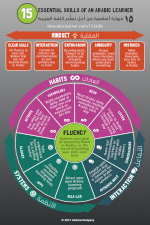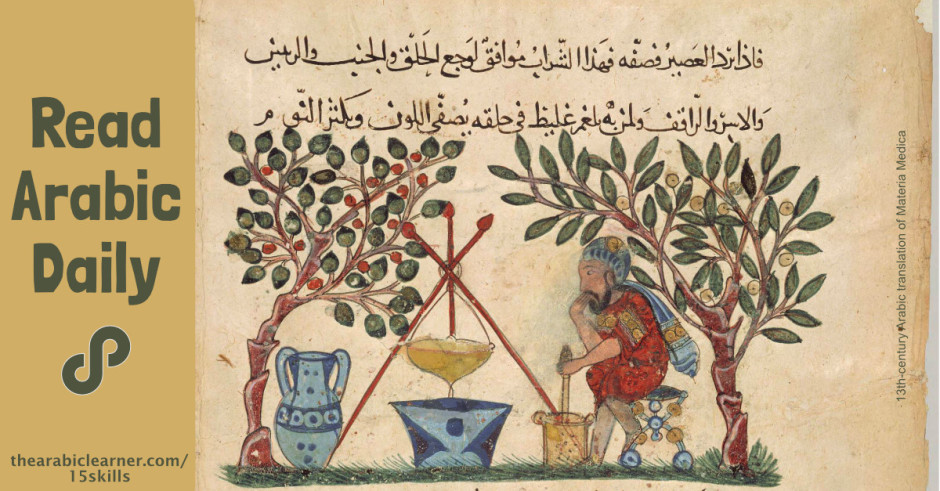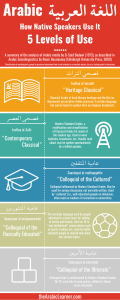Read Arabic to develop proficiency in the language
 Read Arabic daily, and push yourself to complete reading something in Arabic every day. Reading is foundational to enriching your vocabulary and engraining Arabic structures and styles of discourse into your thinking. It is not difficult to find materials to read in Arabic, whether news, commentary, religious, social media, or many other forms. Try to read things through to their end even when you don’t understand every word. The discipline of reading to the end (whether a chapter, blog entry, tweet, or article) overcomes our tendency to drop focus when we don’t understand everything.
Read Arabic daily, and push yourself to complete reading something in Arabic every day. Reading is foundational to enriching your vocabulary and engraining Arabic structures and styles of discourse into your thinking. It is not difficult to find materials to read in Arabic, whether news, commentary, religious, social media, or many other forms. Try to read things through to their end even when you don’t understand every word. The discipline of reading to the end (whether a chapter, blog entry, tweet, or article) overcomes our tendency to drop focus when we don’t understand everything.
“… we help them to get really good at reading…the proficiency that they develop and the confidence that they develop doing that spills over…” (Kirk Belnap)
This article is based on the 15 Essential Skills of an Arabic Learner.
Reading Arabic as a life skill
I remember standing in Tahrir Square in Cairo in 1991 with a friend who was telling me where he lived, and he pointed in a certain direction and said “Do you see that billboard for Mustapha Ali?”. Mustapha Ali was a company that sold, if I recall correctly, lighting fixtures. My eyes scanned the multitude of billboards in the busy square, and suddenly found the Mustapha Ali one… written مصطفى علي. Suddenly, I felt this incredible feeling of accomplishment, that I had actually negotiated one very small aspect of life using my newly developed skill of reading in Arabic.
7 great sources for those who want to read Arabic
Let me start this post by getting straight to “the goods”. Many people who want to read Arabic just need someone to point them to useful places they can read things. Here’s my current list of 7 very useful places on which you can read Arabic in a way that contributes to your learning the language.
 Al-Jazeera Learning Arabic site – An absolutely great site with huge amounts of useful reading materials, fully vowelized, on a wide variety of topics from news and current events. Includes questions, vocabulary, and exercises. Highly useful for intermediate to advanced readers. My current top pick for Arabic learners who want to read.
Al-Jazeera Learning Arabic site – An absolutely great site with huge amounts of useful reading materials, fully vowelized, on a wide variety of topics from news and current events. Includes questions, vocabulary, and exercises. Highly useful for intermediate to advanced readers. My current top pick for Arabic learners who want to read.
![]() Read Arabic! اقرأ العربية site. Funded by the US Department of Education, the materials of Read Arabic! were developed to provide online e-learning reading lessons aimed at beginning and intermediate students of the language. Good stuff here.
Read Arabic! اقرأ العربية site. Funded by the US Department of Education, the materials of Read Arabic! were developed to provide online e-learning reading lessons aimed at beginning and intermediate students of the language. Good stuff here.
![]() Google news search. Search for any topic in Arabic, and find news articles about it. Materials you find here are not pedagogically designed for Arabic learners, but are simply authentic input written for Arabic speakers. If you don’t know a search term in Arabic, use Google Translate to come up with an Arabic equivalent for your English topic.
Google news search. Search for any topic in Arabic, and find news articles about it. Materials you find here are not pedagogically designed for Arabic learners, but are simply authentic input written for Arabic speakers. If you don’t know a search term in Arabic, use Google Translate to come up with an Arabic equivalent for your English topic.
 Wikipedia Arabic pages. Everyone knows Wikipedia. What you may not realize is that by starting on the Arabic homepage of Wikipedia, you may enter a search for any topic in English, and the results will show Arabic language articles for that topic. Extremely useful for finding reading material relevant to specific topics.
Wikipedia Arabic pages. Everyone knows Wikipedia. What you may not realize is that by starting on the Arabic homepage of Wikipedia, you may enter a search for any topic in English, and the results will show Arabic language articles for that topic. Extremely useful for finding reading material relevant to specific topics.
 The Qur’an. There are numerous websites that place the Arabic version of the Qur’an alongside English translations. If you are interested in religious Arabic, this can be an excellent resource for reading classical Arabic. Note that Qur’anic Araic is not the same as Modern Standard Arabic, but will still be beneficial for learners of MSA. Because of the prominent role played by religion in the Arab world, using religious texts to develop reading skills is highly relevant.
The Qur’an. There are numerous websites that place the Arabic version of the Qur’an alongside English translations. If you are interested in religious Arabic, this can be an excellent resource for reading classical Arabic. Note that Qur’anic Araic is not the same as Modern Standard Arabic, but will still be beneficial for learners of MSA. Because of the prominent role played by religion in the Arab world, using religious texts to develop reading skills is highly relevant.
 The Bible. There are also websites that place Arabic translations of the Bible alongside English translations. This can be a very helpful source not only for the reasons mentioned above (that religion is highly relevant in the Arab world), but also in that the Arabic language used in translations of the Bible tends toward Modern Standard Arabic, and may be an easier source for beginner and intermediate levels than the Qur’an.
The Bible. There are also websites that place Arabic translations of the Bible alongside English translations. This can be a very helpful source not only for the reasons mentioned above (that religion is highly relevant in the Arab world), but also in that the Arabic language used in translations of the Bible tends toward Modern Standard Arabic, and may be an easier source for beginner and intermediate levels than the Qur’an.
![]() Arabic: Learning to read Arabic – a beginners’ guide. This is an instructional booklet for beginners who wish to learn to read Arabic. It is designed for independent study using a step-by-step approach, with reading materials in it. University of Durham Language Centre.
Arabic: Learning to read Arabic – a beginners’ guide. This is an instructional booklet for beginners who wish to learn to read Arabic. It is designed for independent study using a step-by-step approach, with reading materials in it. University of Durham Language Centre.
Reading develops proficiency in understanding deep structures
Learning to read well in Arabic has a spill over effect into many other areas of your Arabic language learning. Reading helps to develop proficiency in Arabic, and will strengthen all of the others skills (listening, speaking, and writing). In the words of Abbas Al-Tonsi, co-author of الكتاب في تعلم العربية (al-Kitaab fii Ta3allum al-3arabiyya) – the most widely used academic textbook for learning Arabic in universities – “Effective Arabic learners are the ones who listen a lot and read a lot”[1].
 One of the advantages of reading is that it helps Arabic learners to develop their ability to decode the “surface structure” of Arabic, in order to focus their cognitive energy on the “deep structure” or meaning. Languages are generally understood to have a surface structure and a deep structure, a concept first theorized by the famous linguist and cognitive scientist Noam Chomsky in his book Syntactic Structures (1957). The surface structure is the outward form of the language. The grammar, word forms, and way that the language is written all make up the surface structure, and these need to be “decoded” by the reader in order to understand the actual underlying meaning of what is being said (the deep structure). The reason why it’s possible to say or write the same thing in two different ways is because there can be multiple surface structures for a single deep structure. The surface structure is just a vehicle by which the deep structure is transmitted.
One of the advantages of reading is that it helps Arabic learners to develop their ability to decode the “surface structure” of Arabic, in order to focus their cognitive energy on the “deep structure” or meaning. Languages are generally understood to have a surface structure and a deep structure, a concept first theorized by the famous linguist and cognitive scientist Noam Chomsky in his book Syntactic Structures (1957). The surface structure is the outward form of the language. The grammar, word forms, and way that the language is written all make up the surface structure, and these need to be “decoded” by the reader in order to understand the actual underlying meaning of what is being said (the deep structure). The reason why it’s possible to say or write the same thing in two different ways is because there can be multiple surface structures for a single deep structure. The surface structure is just a vehicle by which the deep structure is transmitted.
Put simply, increasing your ability in reading causes an increase in understanding of both the form and the meaning of Arabic, and enables you to understand and communicate deep meaning more effectively.
Reading develops proficiency in vocabulary
Another broadly accepted benefit of being able to read is that it builds vocabulary (see my post last week on building vocabulary). This can also be related to the concept of surface and deep structure, because increasing familiarity with vocabulary allows a higher accuracy in surface structure decoding. Vocabulary is an essential part of the surface structure, and opens up greater possibilities for communicating and understanding deep structures. Reading provides one of the best ways to learn vocabulary in context. As Dr. David Wilmsen pointed out to me, “In reading… you can connect vocabulary with words you may not know very well in context”[2].
Put simply, the more you read Arabic, the more your vocabulary grows. And the more your vocabulary grows, the more you are able to understand and produce Arabic language that communicates clearly.
The more you advance in your Arabic proficiency, the more important it is to read Arabic. At the intermediate level, there is a need to develop comprehension in reading on a wide range of topics. At the advanced level, increasing the speed of reading through extensive practice is a primary goal[3]. At the university level, reading is used as a main indicator of progress for students learning Arabic[4].
Developing a daily habit of reading Arabic
 Like most things, when it comes to reading Arabic, most of us are best served by developing a habit. A habit, once formed, takes the decision-making variable out of whether or not we ready daily. Often times it is not a lack of time or energy that prevents us from doing what we know will help us learn effectively, but a lack of willpower. Habits bypass willpower, once they are formed. Which is why I like to form habits!
Like most things, when it comes to reading Arabic, most of us are best served by developing a habit. A habit, once formed, takes the decision-making variable out of whether or not we ready daily. Often times it is not a lack of time or energy that prevents us from doing what we know will help us learn effectively, but a lack of willpower. Habits bypass willpower, once they are formed. Which is why I like to form habits!
Here are some ways that you can engage in reading Arabic:
- Silent reading – reading to yourself silently
- Oral reading – reading out loud, whether to a language partner or teacher, or to yourself.
- Extensive reading – reading long passages for overall comprehension, not stopping to understand every word
- Intensive reading – reading shorter passages in detail, being sure to understand every word and structure
I have found that a blend of these approaches works best for me. This calls on a wide variety of skills, and keeps my interest high.
I have also found that it is important to complete reading tasks in Arabic, even short ones. By this I mean finishing off what I start to read. I have a tendency to begin to read something, and then get lazy and drop off partway through the passage because it takes me longer to read in Arabic than it does in English (I do the same in French). This happens to me in books, news articles, or social media posts… even things as short as tweets on twitter! Holding myself to a discipline of completing things that I begin reading helps me to really stretch and improve my skill.
The challenge of the alphabet
For many learners of Arabic whose first language uses the Latin script for writing (including English and other European languages), the Arabic alphabet and writing system can be a hurdle that looks difficult and often discourages reading. For learners whose first language does not use Latin script, such as Cyrillic or Chinese, it still comes across as a hurdle, although many speakers of these languages have often already had to cross the barrier of working with a different writing system in their academic pursuits, and so the psychological hurdle of the Arabic alphabet may not seem as big.

Whatever the case, the Arabic alphabet can be initially discouraging for people who want to read Arabic. But the benefits of learning to read Arabic far outweigh the inconvenience of a new writing system. In my experience, as well as in the experience of many others with whom I have spoken, the difficulty of using a new script begins to decrease after a week or so of regular use. I have put together a simple page of short videos on how the basic (isolated) form of each Arabic letter is formed. This may be helpful for some people. There is an order to how each stroke is made, and the direction of the stroke. At some point, I may try to add the other forms of each letter (initial, medial, and final).
The challenge of Modern Standard Arabic vs. Dialects
Another challenge for those learning to read Arabic is that written Arabic does not match the dialects of Arabic spoken across the Arab world. The Arabic of writing is known as Modern Standard Arabic (or often referred to as فُصْحَى / fuSHa, which is not technically the same thing but for our purposes here will work), while the spoken dialects are often referred to as عَامِّيَّة / 3aammiyya.
This is a situation that is known as diglossia in linguistics, when two dialects or languages are used by a single language community, and it is often seen as presenting Arabic learners with a difficult decision when they begin to learn. Should they begin with Modern Standard Arabic that is not spoken by people on an everyday basis, or start with a dialect at the expense of being able to fluently read?
However, bear in mind that the situation is not a simple black and white scenario where Modern Standard Arabic is on one side, and dialects on the other. The reality is that in real life, they are blended together in varying levels, depending on the context and situation. I have written a previous article on this, and the following diagram illustrates some of the aspects of this.
This diagram makes it clear that the “diglossia” situation, or the split between “classical” and “colloquial” Arabic, is not an entirely accurate assessment of the situation. Dr. Kristen Brustad, also co-author of الكتاب في تعلم العربية (al-Kitaab fii Ta3allum al-3arabiyya) says that the concept of diglossia in Arabic is an “ideology and not a linguistic reality”[5], which may explain why the most recent edition of the Al-Kitaab textbook series teaches both فُصْحَى / fuSHa and عَامِّيَّة / 3aammiyya in a combined approach.
Whatever the correct balance is, what is clear is that learners of Arabic are best served by giving at least some of their focus to the goal of learning to read Arabic.
To read in Arabic is to practice one of the essential skills of an Arabic learner. If you have found resources or ideas that are particularly helpful for increasing reading skill in Arabic, please comment below and share your ideas with other readers.
- [1] Personal interview with Abbas Al-Tonsi, May 1, 2015
- [2] Personal interview with Dr. David Wilmsen, April 28, 2015
- [3] Personal interview with Dr. David Wilmsen, April 28, 2015
- [4] Personal interview with Dr. Aiyub Palmer, May 21, 2015
- [5] Personal correspondence with Dr. Kristen Brustad, May 19, 2015.



 RSS - Posts
RSS - Posts
Good afternoon, Andrew,
Once again I must thank you for some vital info that I would never have found on my own. I knew about the on-line Noble Qoran site, to which I often go, but had not known about the others. And the two top ones you’ve advertised look absolutely spiffing. I shall go there. My trouble is that I am having full days sub-editing fractured English, much of which seems to have been codified by the notorious WWII Enigma machine and I don’t have much time for reading.
But more another time.Thank you again,
Thanks for the feedback Ramez. I enjoyed putting this list together. There was a lot of chaff to sift through, but I think there’s some good stuff in there.
Sounds like you’ve got enough chaff on your hands in your English editing to keep you busy!